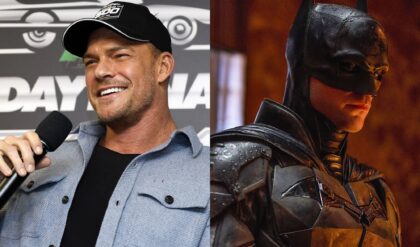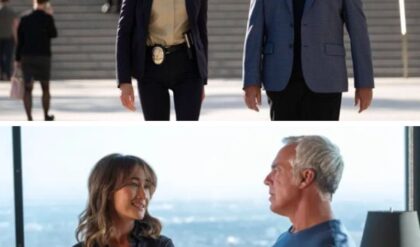Nestled in the craggy embrace of the Scottish Highlands, where ancient mountains claw at storm-lashed skies and mist clings to the heather like a shroud, lies a body of water that has haunted imaginations for centuries. Loch Ness isn’t just a lake—it’s a primordial abyss, 23 miles of ink-black depths plunging to 755 feet, rumored to cradle a beast older than time itself. The plesiosaur-like silhouette that first slithered into folklore in the 6th century, courtesy of Saint Columba’s tales of vanquishing a water demon, has spawned a modern mythos: grainy photos, sonar blips, and tourist traps hawking Nessie plushies and boat tours. But in the 2017 ITV miniseries The Loch (retitled Loch Ness for its U.S. debut on Acorn TV), the monster isn’t the finned phantom lurking below—it’s the human predator stalking the shores, carving terror into the heart of a sleepy village. Penned by Stephen Brady, this six-episode thriller weaves a serial killer’s savagery with the loch’s eldritch allure, pitting a tenacious local detective against a double homicide that drags buried sins to the surface. As DS Annie Redford unravels the threads of mutilated corpses and midnight whispers, the line between myth and madness blurs: could Nessie—or the obsession with her—be the killer’s cryptic calling card? Eight years after its premiere, with a fresh surge on Netflix propelling it to global charts, The Loch remains a fog-shrouded fever dream, proving that the scariest beasts are the ones we create ourselves. If Broadchurch chilled you with coastal claustrophobia, this Highland horror will leave you scanning the depths for shadows that move.
The series unfurls like a Highland reel: slow, hypnotic, then whipping into a frenzy of twists that snag like barbed hooks. Lochnafoy, the fictional hamlet hugging Loch Ness’s southwestern tip, is a postcard of pastoral peril—cobblestone lanes flanked by whitewashed cottages, a kirk steeple piercing the gloaming, and tour boats bobbing like bait on glassy waters. The economy thrives on the monster trade: Nessie-spotting cruises, a kitschy museum hawking “evidence” of humps and humps, and locals spinning yarns of sightings to wide-eyed Yanks. But beneath the tourist gloss simmers a community bound by blood and grudges, where everyone knows your sins but whispers them in Gaelic. The nightmare erupts in episode one when a body surfaces near the foot of Carn Mòr, Scotland’s eighth-highest peak—a jagged sentinel of schist and scree looming over the loch like a judgmental god. It’s Niall Swift, the village’s piano tutor and an outsider with a penchant for pretty boys, his skull violated in a ritualistic horror: brain matter scooped out through the nasal cavity, à la ancient Egyptian mummification, while he was still conscious enough to feel the agony. Divers dredge up more: a human heart, fresh and unclaimed, tangled in the weeds. Not one murder—a double homicide, signaling a serial sadist with a flair for the theatrical.
Enter DS Annie Redford, the beating, bleeding heart of the hunt. Portrayed by Laura Fraser with the flinty resolve of a woman forged in Highland gales, Annie is Lochnafoy’s prodigal daughter—returned from the big city to raise her teenage hellion alone after a messy divorce. She’s no stranger to the badge, but this is her first lead on a capital case, a baptism by blood that tests her mettle against the brass from afar. Fraser, fresh off her gut-wrenching turn as the grieving mother in The Missing, imbues Annie with a coiled intensity: sharp-tongued and surf-sure, she navigates the loch’s currents like a selkie, but her home front is a riptide. Her daughter Evie (Shona McHugh, all brooding brows and bitten lips) is a powder keg of adolescent angst, chafing under mum’s watchful eye while tumbling into a vortex of bad decisions—skipping school for smokes and secrets with her mates, Kieran and Jonjo. Evie’s orbit becomes the emotional eye of the storm, her rebellion mirroring the village’s unraveling as the killings escalate.
Reinforcements arrive in the form of DCI Lauren Quigley, a Glasgow import played by Siobhan Finneran with the icy precision of a stiletto in fog. Finneran, the scheming O’Brien from Downton Abbey reborn as a no-nonsense copper, brings a metropolitan edge that clashes gloriously with Annie’s local lore. Lauren’s got history here—tied to DCI Frank Smilie (the late John Sessions, in one of his final roles, oozing avuncular sleaze)—and her outsider status amplifies the us-versus-them tension. Together, they form a mismatched duo: Annie’s intuitive leaps versus Lauren’s by-the-book battering ram, their banter crackling like heather burning on the hillside. The ensemble fleshes out Lochnafoy’s fractured tapestry: Don Gilet as DC Ben Calder, Annie’s loyal if green deputy, fumbling forensics with earnest charm; Alastair Mackenzie as lawyer Adam Sunter, a pillar of propriety hiding fractures; and a rogue’s gallery of suspects—the grieving widow Mhari Toner (Simone Lahbib, delivering a tour de force of maternal torment), the twitchy tour guide Leighton (KeKe McDonald), and the enigmatic Jordan Whitehead (whose arc spirals into the series’ gut-wrenching core).
Brady’s script, honed on Fortitude‘s Arctic chills and Vera‘s Geordie grit, deploys the loch as both muse and menace. Nessie isn’t a literal lurker—no flippers flashing in the frame—but a spectral symbol woven into the killer’s psyche. The murderer leaves taunts echoing the myth: bodies dumped where “sightings” cluster, organs harvested like offerings to a watery deity, whispers of “the beast” scrawled in blood. Is it a zealot avenging the commercialization of the legend, or a psycho toying with the town’s tourist trap? As Annie dives deeper—literally, in a submersible probing the loch’s murk—the investigation dredges up generational guilts: land grabs from the Clearances, buried abuses in the kirk, and a ’90s scandal that scorched the village like wildfire. Subplots simmer like stew on a peat fire: Evie’s clique uncovers a “skeleton” hoax that spirals into real peril, testing teen loyalties; a forensic shrink (Jamie Sives) profiles the killer as a “craver of chaos,” his sessions laced with Freudian fog; and romantic undercurrents ripple between Annie and a suspect, adding salt to her professional wounds. The pacing builds like a swell: languid exposition in the gloaming episodes giving way to hairpin pursuits along single-track roads, where deer eyes glow like accusatory orbs in headlights.
Filming on location elevates The Loch from procedural potboiler to atmospheric opus. Shot in the summer of 2016 amid Scotland’s mercurial clime—lashing rains one dawn, golden gloaming the next—the production claimed Fort Augustus as Lochnafoy’s beating heart. This abbey-turned-village at Loch Ness’s southern tip, with its canal locks churning like mechanical hearts and Highland Club looming like a laird’s lair, pulses with authenticity. Carn Mòr’s flanks, scarred by ancient landslides, frame the cliff plunge; Glencoe’s brooding glens stand in for misty moor chases, their basalt columns whispering of clan massacres past. Interiors hopped to Glasgow studios for autopsy bays and interrogation cells, but the loch’s edge owns the screen: cinematographer John McNicholas bathes it in desaturated blues and bruised purples, mist machines conjuring the uncanny valley where reality frays. Composer toxu, blending Celtic harp with dissonant drones, scores the unease—strings swelling like sonar pings as divers descend, a lone bagpipe keening over credits like a banshee’s wail. It’s a sensory immersion: you feel the chill seep through your screen, taste the peaty tang of single malt in tense pub standoffs, hear the lap of waves masking muffled screams.
The murders mount with macabre invention, each a puzzle piece in the killer’s mosaic. Swift’s evisceration yields to a second victim—a heart donor match, yanked from a “disappeared” fisherman—prompting a frantic sweep of the loch’s 144 square miles. Annie’s team combs tour logs for Nessie obsessives, uncovers a black-market organ ring tied to desperate Highlanders, and grapples with red herrings that hook deep: a bipolar teen’s blackout, a widow’s illicit affair, a laird’s land feud. Mid-season detonates with a revelation that shatters the village’s facade, linking the killings to a long-buried trauma from the ’90s—a “monster hunt” gone monstrously wrong. The finale, a rain-swept race against the tide, unleashes a cascade of shocks: betrayals that gut like gutted trout, a maternal showdown in the kirk’s shadowed nave, and a denouement where the loch swallows secrets whole. Without spoiling the beastly reveal, suffice it to say the killer’s identity—a twist that had viewers howling “No!” at their tellies—reframes Nessie not as culprit, but as camouflage for human horror. It’s Se7en meets The Wicker Man, with the loch’s depths mirroring the abyss in every soul.
Upon its June 2017 ITV bow, The Loch stirred a Highland tempest of reception—mixed as a dram of whisky and water. Metacritic’s 67/100 tagged it “generally favorable,” praising the “haunting depth” of its setting but docking for “red herrings muddying the melodramatic denouement.” Rotten Tomatoes clocked 60% from critics, who split hairs: The Telegraph hailed its “jaunty entertainment about serial killing,” a “Scottish Broadchurch with bite,” while The Daily Mail dismissed it as a “disjointed head-scratcher” piling “ludicrous events” into laughable disbelief. Radio Times faulted the “flat” characters, likening moody teens to “soapland” stereotypes, yet conceded the plot’s “exciting” promise. Audiences leaned warmer, IMDb’s 6.9/10 buoyed by fans raving over Fraser’s “compelling” lead and the “vibrant” visuals: “Great scenery!!! Looks wonderfully vibrant—you will marvel,” one gushed, while another deemed it “better than Broadchurch‘s pompous self-importance.” Detractors griped at “paint-by-numbers” tropes—the neglected hubby, the troubled teen—but even they admitted the twist’s sucker punch: “I read a lot of crime fiction but didn’t see that coming. Bravo!”
The real resurrection came in July 2025, when Netflix’s global drop catapulted Loch Ness to No. 1 charts, outpacing fresh fare and reigniting the frenzy. X (formerly Twitter) erupted: “Binge-watched Loch Ness on Netflix this evening. Thoroughly enjoyed it!” trilled one, while another confessed, “Several years too late… but what a fantastic crime-drama! Hooked.” Skeptics sniped—”Guys, don’t waste your time. You’re welcome”—but the tide turned tidal, with threads buzzing over the finale’s “shock rise” and pleas for a sequel: “Roll on series two!” Forums like Reddit’s r/television dissected the myth-killer nexus, fans theorizing Nessie’s “evidence” as forensic foreshadowing. In a post-Happy Valley era craving gritty Scots noir, The Loch found its sea legs anew, its 2025 viewership eclipsing the original by millions. Brady, in sparse post-premiere chats, teased the loch’s “untamed nature” as inspiration, hinting at untapped depths for more—though no renewal’s surfaced, the clamor echoes like a depth charge.
What endures The Loch‘s chill isn’t flawless plotting—subplots snag like weeds, some twists teeter on telenovela thin ice—but its masterful meld of myth and malice. The Highlands emerge as a character colossal as the loch: untamable, unforgiving, a land where clans’ ghosts mingle with tourists’ selfies, and every glen guards a grudge. Annie’s arc—a mother’s fierce forge in the fire of fear—resonates as a requiem for working women warriors, her quips (“This beast’s got more teeth than our budget”) cutting sharper than any blade. Fraser and Finneran’s chemistry simmers with sisterly steel, a buddy-cop balm amid the brutality. And Nessie? She’s the series’ sly siren, luring us to probe the dark: if a village can birth a monster from mist, what horrors hide in our own backwaters?
Eight years on, as November mists mantle the globe, The Loch beckons binge-watchers to its briny brink. Stream it on Netflix or ITVX, brew a pot of Earl Grey, and let the waters close over you. The killer’s unmasked, but the loch’s secrets? They sink deeper still. Dive in—if you dare. Just mind the ripples: they might be fins… or fingers reaching from below.





